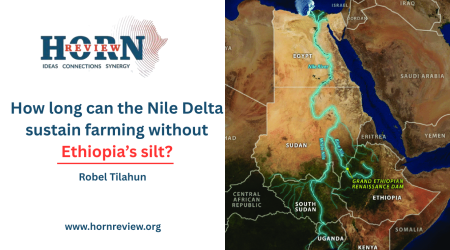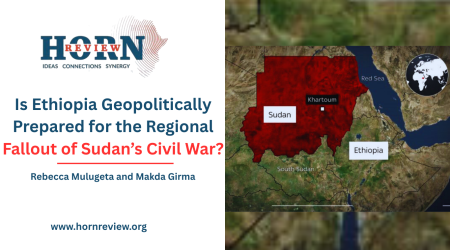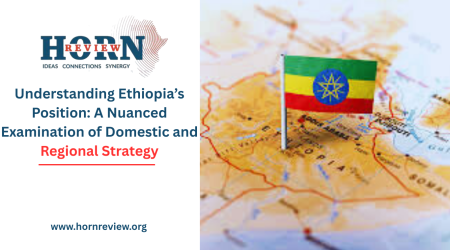
12
May
A Grain of Bias: Why The Economist Keeps Getting Africa Wrong—The latest is Ethiopia’s Wheat?
In its March 13, 2025, article titled “Abiy Ahmed’s Agricultural Revolution: Too Good to be True” The Economist struck a familiar tone, suspicious, dismissive, and patronizing towards Africa.The target of the latest piece was Ethiopia’s reported wheat production gains. The piece alleges that Prime Minister Abiy Ahmed’s claim of wheat self-sufficiency is not just exaggerated but possibly fabricated.
The argument leans heavily on satellite data from Western institutions like the USDA and FAO, and once again frames an African success story as “too good to be true.”
To assess the claims made by The Economist regarding Ethiopia’s wheat production, this rebuttal employs a multi-faceted approach, combining primary data, expert consultations, and contextual analysis. Additionally, we examined The Economist’s patronising African reporting history, methodologies cited by The Economist to identify discrepancies or biases in their analysis, and their ideological biases.This piece aims to present a balanced evaluation of Ethiopia’s agricultural progress.
The Economist’s African Narrative
The Economist has a long history of framing Africa through a lens of pessimism and stereotypes. In 2000, they labelled Africa as “the hopeless continent” on their cover story. Its recent articles continue to emphasize poverty, corruption, and conflict over progress. Its coverage often focuses on a narrow set of African countries, reinforcing the notion of a monolithic continent, and sidelining voices from ordinary African farmers.
This selective storytelling aligns with critiques that Western media, including The Economist, prioritize narratives that serve corporate or geopolitical interests, such as supporting austerity policies that have historically harmed post-colonial economies. The Economist has consistently shown that its allegiance lies more with interpreting facts that fit its Eurocentric worldview and narrative power than empirical balance. Ethiopia is simply the latest in a long line of misjudged stories. Ethiopia’s agricultural transformation, driven by large-scale policy shifts and agronomic innovation, is not a mirage. It’s an unfolding success story that doesn’t need to be perfect to be real.Yet The Economist, true to form, clings to outdated models, imported assumptions, and a condescending skepticism rooted more in ideology than evidence.
Modeling Truth Around Bias
The Economist’s argument is built around satellite models from the USDA and FAO, which suggest Ethiopia could not have produced 15–23 million tonnes of wheat. These models, however, are notoriously inaccurate in smallholder, fast-changing agricultural systems. What The Economist fails to admit is that remote sensing is only as good as the assumptions behind it and these models haven’t been calibrated with Ethiopian field data since 2021.
Instead of questioning the validity of models that haven’t been updated in years, The Economist questions the validity of the lived experiences of millions of farmers. Why? Because in their editorial worldview, models from Washington are inherently more trustworthy than field data from Addis Ababa. This isn’t objective journalism, it’s evidence manipulation wrapped in the illusion of empiricism.
The Colonial Comfort of Western Estimates
The Economist’s critique of Ethiopia’s wheat production gains reveals more than a dispute over numbers; it exposes a deeply rooted worldview that privileges Western perspectives. The article instinctively trusts data from the USDA and FAO while casting the Ethiopian government as inherently unreliable. But why is Western data accepted as gospel, while African data is treated with suspicion?, despite the FAO’s own admission that it has not received updated statistics from Ethiopia in years. Meanwhile, Prime Minister Abiy Ahmed’s innovative reforms earned him the prestigious FAO Agricola Medal for advancing wheat self-sufficiency, a feat also lauded by figures like Bill Gates and institutions such as the African Development Bank. This contrast lays bare a troubling pattern: The Economist consistently upholds a Eurocentric hierarchy of knowledge.
In this worldview, African data and expertise are dismissed unless validated by institutions in Geneva, Washington, or Rome. Ethiopia’s sophisticated monitoring systems, robust extension services, and advanced satellite platforms, developed through years of investment, are sidelined in favor of outdated or generalized Western metrics. The Economist’s narrative implies that knowledge is only legitimate when it originates outside Africa, ignoring the continent’s growing capacity to generate credible, localized insights. This bias not only distorts Ethiopia’s agricultural success but also perpetuates a broader marginalization of African agency in global discourse.In The Economist’s world, knowledge is only real when it’s foreign to Africa.
Ignoring the Geography of Change
One of the most glaring blind spots in The Economist’s piece is its total disregard for the spatial transformation of Ethiopian wheat production. Wheat is no longer a highland-only crop. Through irrigation expansion and cluster farming, the Ethiopian government has brought wheat to the lowlands, the dry season, and even institutional lands like airport grounds and university campuses.
These changes are transformational, but The Economist ignores them, likely because satellite models trained on historical patterns don’t recognize them. Rather than ask why the models are missing new trends, the article doubles down on them, treating the data as sacred and the reality as suspect. That’s not journalism. That’s dogmatism.
Statistical Confusion as Political Weaponry
When Ethiopia’s Central Bank temporarily published a figure of 5.8 million tonnes, later removed, the article pounced, suggesting foul play. But the government explained it was a publication error. Any seasoned observer knows bureaucratic inconsistencies happen, especially in reforming systems.
But The Economist has no time for nuance. It conflates clerical errors with conspiracy, using the episode to paint a picture of state deception. It’s an old trick: discredit African governments by holding them to impossible standards of bureaucratic perfection while ignoring the historical errors of Western technocracies. Remember when The Economist confidently endorsed austerity policies across Europe that led to economic collapse? Or its botched takes on Brexit, which underestimated its political momentum? Their record of “getting it wrong” is as long as it is quietly forgotten.
Absent From the Field, Present in the Echo Chamber
Notably missing from The Economist’s analysis? Actual Ethiopian farmers. Or traders. Or millers. Or extension workers. The article cites no field reports, no surveys, and no voices from the ground. Instead, it reads like it was written in a boardroom in London, echoing satellite figures and institutional talking points.
Had the writers spent time in Ethiopia’s wheat-producing zones, they would have seen dry-season wheat on previously barren lands, modern combine harvesters operating in clusters, and local markets more abundant with grain than in recent memory. But The Economist prefers abstraction over reality, it’s cleaner that way, and easier to fit the narrative.
Policy and Infrastructure Don’t Fit the Narrative
Another thing The Economist conveniently omits? The government-led investments that have made this transformation possible. From removing taxes on machinery imports, to distributing improved seeds and fertilizers, to scaling irrigation via solar pumps and canals, Ethiopia’s wheat success is not accidental. It’s engineered.
But because the story doesn’t fit the “African governments as dysfunctional” trope, The Economist discards it. The reality that a coordinated, state-led effort could produce tangible success simply doesn’t align with the publication’s ideological preference for market-led reform and skepticism of state capacity in Africa.
Trade Data Twisted to Fit the Frame
The article uses the existence of wheat imports as a smoking gun: if Ethiopia is self-sufficient, why is wheat still coming in? This line of reasoning is either shockingly naive or willfully misleading. Ethiopia hosts millions of refugees, and donor-driven aid imports are a major part of the country’s food system. Moreover, remaining in international grain markets is a strategic choice that many self-sufficient countries make to hedge risks and ensure price stability.
What’s more, Ethiopia shares porous borders with countries like Somalia and Sudan. Informal wheat exports, untracked and untaxed, are common. But The Economist doesn’t mention this. It cherry-picks data that supports its doubt and ignores data that complicates it.
Even the Conservative Math Works
Let’s leave ideology behind and crunch the numbers. Ethiopia’s average rainfed wheat area is 2.1 million hectares. At 3 tonnes per hectare, that’s 6.3 million tonnes. Add 1.05 million hectares of irrigated wheat at 4 tonnes per hectare, another 4.2 million tonnes. Include newly irrigated land, 1.25 million hectares at similar yields, and you get 5 million tonnes more.
That’s a conservative total of 15.5 million tonnes, and that’s before double cropping, which is increasingly common. With two growing seasons and a coordinated extension campaign, 20–23 million tonnes is not a stretch, it’s a reality waiting to be acknowledged.
The Yield Gap They Refuse to Talk About
Silva (2021) notes that Ethiopia’s wheat productivity sits at just 20% of its rainfed potential and 30% of its irrigated potential. Even modest improvements, to 50% and 60% respectively, would yield an additional 4+ million tonnes annually.
That’s not magic. That’s what happens when farmers get timely information, access to mechanization, and inputs that work. The Economist, however, pretends yield gaps don’t exist, perhaps because admitting them would mean admitting Ethiopia has room to grow, and the capacity to do so.
Conclusion: What The Economist Won’t Say
The Economist is right to demand accountability when public figures make bold claims. But in this case, it underestimates Ethiopia’s complex and fast-moving agricultural reforms. By over-relying on outdated models, dismissing credible agronomic scenarios, and ignoring the people actually growing the wheat, the article tells a story that is at best partial, and at worst, patronizing.
A more honest critique would challenge all assumptions, not just those coming from African governments. It would blend satellite data with farmer surveys and market flows. It would recognize the scale and speed of Ethiopia’s agronomic shift. And it would call for better monitoring, not to undermine success, but to strengthen it.
Ethiopia’s wheat revolution is not perfect. But it is real. It is measurable. And yes, even by the most conservative math, it is entirely possible. Dismissing it as fantasy says more about the storyteller than the story.
By Birhanu M Lenjiso (PhD)
By Tesfaye S Sida (PhD)










